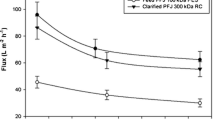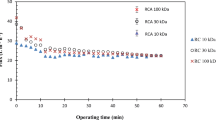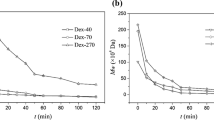Abstract
The separation characteristics of two polyethersulfone membranes (molecular weight cut-off (MWCO) specification of 4 kDa and 10 kDa) for the retention of different dextran fractions (T2000, T40, T10) from aqueous solutions were systematically investigated, aiming at implementing them as a preparatory step for dextran analysis in sugar industry practice. Ultrafiltration is used to cause differences in optical rotation due to mechanical separation of dextran from aqueous solutions. The membrane separation performance was evaluated using polarimetry and size exclusion chromatography. It was found that the presence of sucrose leads to dramatically improved separation efficiencies for both membrane settings. Specific cut-off values for the separation of dextran from aqueous sucrose solutions have been determined, 10 kDa and 50 kDa for the membranes with a MWCO specification of 4 kDa and 10 kDa, respectively. The data indicate that the basic membrane setting (MWCO of 4 kDa) enables the complete separation and therefore the analytical quantification of the whole molecular mass spectrum relevant for sugar industry. The combination of both membranes, furthermore, indicates that it is suited for the differentiation between a high and a low molecular mass dextran fraction. The application of this new approach for the determination of dextran with varying molecular masses at various contents in synthetic thin juices as well as in real sugar beet raw juices indicates promising prospects.






Similar content being viewed by others
References
Abdel-Rahman, E.-S. (2007) Investigations on the influence of dextran during beet sugar production with special focus on crystal growth and morphology. PhD. Berlin
Abraham, K., & Flöter, E. (2018). New approaches for the determination of dextran in the sugar production process. Sugar Industry
Antoniou E, Themistou E, Sarkar B, Tsianou M, Alexandridis P (2010) Structure and dynamics of dextran in binary mixtures of a good and a bad solvent. Colloid Polym Sci 288:1301–1312
Aquino FW, Franco DW (2009) Molecular mass distribution of dextran in Brazilian sugar and insoluble deposits of cachaça. Food Chem 114:1391–1395
Baker RW (2004) Membrane technology and applications, 2nd edn. Wiley, Chichester, New York
Belitz H-D, Grosch W, Schiberle P (2008) Lehrbuch der Lebensmittelchemie: 6. Auflage. Springer Berlin Heidelberg, Berlin Heidelberg
Bergmann A, Orthaber D, Scherf G, Glatter O (2000) Improvement of SAXS measurements on Kratky slit systems by Göbel mirrors and imaging-plate detectors. J Appl Crystallogr 33:869–875
Breßler I, Kohlbrecher J, Thünemann AF (2015) SASfit: a tool for small-angle scattering data analysis using a library of analytical expressions. J Appl Crystallogr 48:1587–1598
Chen, J. C., & Chou, C. C. (1993) Cane sugar handbook: a manual for cane sugar manufacturers and their chemists: Wiley
Day DF, Sarkar D (1986) Methods of analysis for dextran in sugar molasses and juice. Proc Int Soc Sugar Cane Technol:748–754
Gasciolli V, Choplin L, Paul F, Monsan P (1991) Viscous properties and molecular characterization of enzymtically size-controlled oligodextrans in aqueous solutions. J Biotechnol:192–202
Hamid N, Ismail AF, Matsuura T, Zularisam AW, Lau WJ, Yuliwati E, Abdullah MS (2011) Morphological and separation performance study of polysulfone/titanium dioxide (PSF/TiO2) ultrafiltration membranes for humic acid removal. Desalination 273:85–92
Hirata Y, Sano Y, Aoki M, Shohji H, Katoh S, Abe J-i, Hitsukuri S, Yamamoto H (2003) Small-angle X-ray scattering studies of moderately concentrated dextran solution. Carbohydr Polym 53:331–335
ICUMSA (ed) (2011) ICUMSA method book. Dr. Albert Bartens KG, Berlin
Lee G, Nowak W, Jaroniec J, Zhang Q, Marszalek PE (2004) Molecular dynamics simulations of forced conformational transitions in 1,6-linked polysaccharides. Biophys J 87:1456–1465
Morris GA, Ralet M-C (2012) The effect of neutral sugar distribution on the dilute solution conformation of sugar beet pectin. Carbohydr Polym 88:1488–1491
Orthaber D, Bergmann A, Glatter O (2000) SAXS experiments on absolute scale with Kratky systems using water as a secondary standard. J Appl Crystallogr 33:218–225
Pasch H, Trathnigg B (1998) HPLC of polymers. Springer, Berlin Heidelberg
Promraksa, A. (2008) Reduction of dextran contamination in raw sugar production. A thesis submitted in partial fulfillment of the requirements for the degree of Doctor of Philosophy in Chemical Engineering
Tvaroska I, Pérez S, Marchessault R (1978) Conformational analysis of (1 → 6)-alpha-D-glucan. Carbohydr Res:97–106
van der Poel PW, Schiweck H, Schwartz T (1998) Sugar technology: beet and cane sugar manufacture. Dr. Albert Bartens KG, Berlin
Wojtczak M, Gruska R, MIkos P, Antczak-Chrobot A (2015) Dextran molecular mass effect on particle size distribution of CaCO3 for 1st and 2nd carbonatation. Sugar Industry:703–706
Acknowledgements
The authors would like to thank the Federal Institute for Materials Research and Testing (BAM, Bundesanstalt für Materialforschung und -prüfung) for performing and evaluating SAXS measurements.
Funding
This study was funded by the WTSH (Wirtschaftsförderung und Technologietransfer Schleswig-Holstein GmbH).
Author information
Authors and Affiliations
Corresponding author
Ethics declarations
Conflict of Interest
K. Abraham declares that she has no conflict of interest. S. Kunst declares that there are no conflict of interest. E. Flöter declares that there are no conflict of interest.
Ethical Approval
This article does not contain any studies with human participants or animals performed by any of the authors.
Informed Consent
Informed consent was obtained from all individual participants included in the study.
Additional information
Publisher’s Note
Springer Nature remains neutral with regard to jurisdictional claims in published maps and institutional affiliations.
Rights and permissions
About this article
Cite this article
Abraham, K., Kunst, S. & Flöter, E. Membrane Characterisation for Fractionated Dextran Analysis in Sugar Industry. Food Anal. Methods 12, 1092–1102 (2019). https://doi.org/10.1007/s12161-019-01441-7
Received:
Accepted:
Published:
Issue Date:
DOI: https://doi.org/10.1007/s12161-019-01441-7




